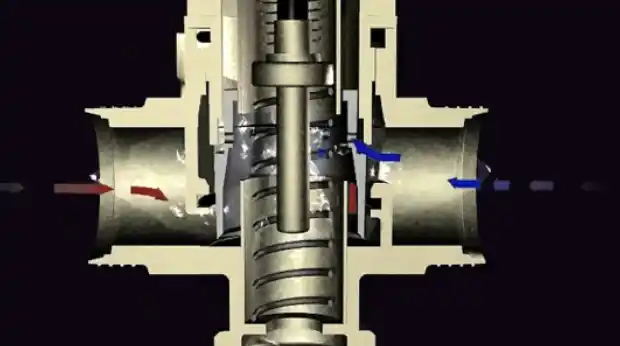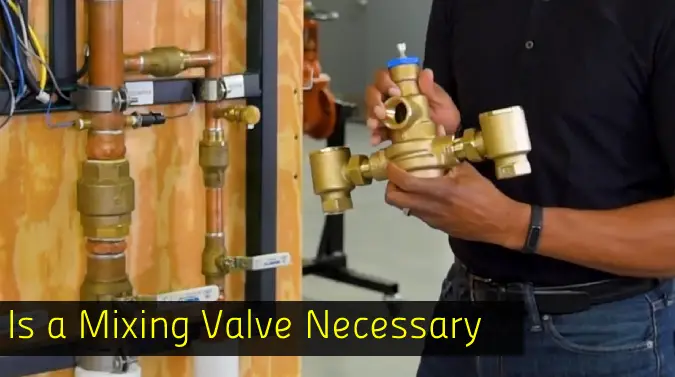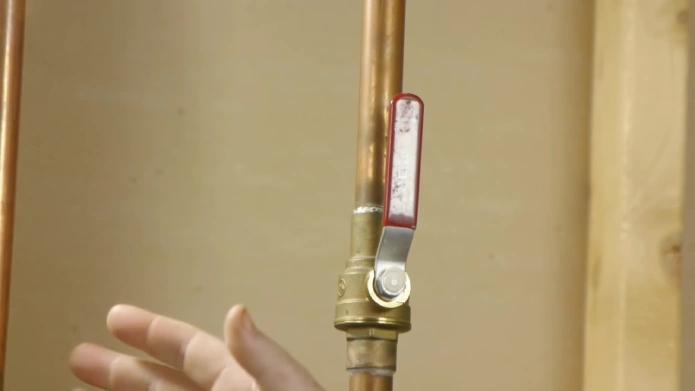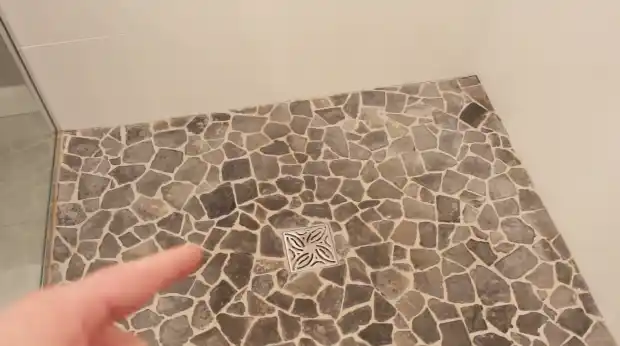Last Updated on May 18, 2023
Investing in a mixing valve is not compulsory, but we recommend it if you want to upgrade your bathroom.
Not only does it regulate the water temperature for ultimate comfort and safety, but it also offers anti-scald protection. That means that you can avoid potential dangers every time you step into the shower and relax in peace.
Mixing valves are also energy efficient as they help reduce hot water usage when used correctly. With a mixing valve, your bathroom will become more secure and comfortable without delay.
Let’s explore why these helpful fixtures are so vital and where they can give your space an extra boost.
Is a Mixing Valve Necessary: Important Reasons

Investing in a mixing valve for your water heater is an easy decision to make once you understand the numerous benefits it can offer. Make sure you take full advantage of this simple solution and reap its rewards.
Here are some reasons why your water heater needs a mixing valve:
Increased Temperature Accuracy
Using a mixing valve with your water heater ensures that the water temperature is consistent and accurate throughout your home. It means that you won’t get scalded in the shower or get cold spots in your house due to uneven heating.
Cost Savings
By controlling the temperature accurately with a mixing valve, you save on energy costs since more precise adjustments need less energy to maintain. This helps make sure your hot water system is running as efficiently as possible, leading to lower energy bills month after month.
Safer Environment
As mentioned before, using a thermostatic mixing valve prevents scalding from happening in any part of your home. It also reduces corrosion from hot water in certain areas like bathrooms and kitchens, which can cause damage over time if not adequately regulated.
Improved Comfort
Mixing valves help improve comfort by providing better control over the temperature than traditional water heaters do on their own. Having greater control over the temperature allows you to set it exactly how you want it.
Added Protection From Dangerous Particles
Your mixing valve protects your plumbing system and water heater from dangerous particles like sediment and dirt. The apparatus filters out these particles, preventing them from getting into your pipes, where they may cause issues later on down the line if left unchecked.
Longer Lasting Water Heater
Mixing valves help reduce pressure levels that can damage your water heater if they are left unregulated for long periods of time. Keeping pressure levels even decreases friction on components like seals and other parts.
Where Should The Water Heater Mixing Valve Be Located?

Answering the question of where the water heater mixing valve should be located can be an important part of any home plumbing job. The mixing valve should always be installed close to the hot water tank to monitor and adjust the hot water’s temperature as necessary.
Mixing valves installed too far from the hot water tank could result in temperature fluctuations that could cause scalding or freezing. When installing a thermostatic mixing valve near a hot water tank, you should make sure that both the cold and hot water lines are connected directly above the tank itself.
The installation process for a mixing valve involves ensuring that it is correctly mounted on an outlet pipe or secured with brackets and screws according to the manufacturer’s instructions. If any pipes are going in or out, make sure there’s enough clearance between the new valve assembly and any nearby objects.
Note: If the mixing valve is connected just beyond the tank, either too much or too little pressure can be applied to the valve, resulting in inconsistent temperatures.
If a Mixing Valve Fails, What Happens?
If a mixing valve fails, the disastrous consequences can range from minor to catastrophic. Failure of a mixing valve can cause the following issues:
Temperature Fluctuations
A faulty mixing valve can cause hot and cold water temperatures to become out of balance, resulting in lukewarm or scalding water. This can be incredibly dangerous if the temperature is too high, and unsuspecting users get burned or scalded by their own taps.
Poor Water Quality
As well as providing even temperatures, mixing valves also ensure that contaminants are not entering the plumbing system through hot or cold water sources. Failure of a valve means sediment, minerals, and other particles can accumulate in pipes and fixtures, causing clogs and smelly water.
Leaks:
Mixing valves typically have multiple seals that can wear out over time from hot water exposure and constant movement from changes in pressure or flow rate. When these seals break down, it can lead to leaks around faucets, showers, or even sinks which are costly to repair.
Pressure Problems
When a mixing valve fails, it can also cause pressure problems like low flow rates or sudden surges in pressure when fixtures are turned on suddenly. This puts an extra strain on your pipes, which may result in further damage if not addressed quickly enough.
Damage to Appliances
If your appliances are exposed to extreme heat and cold over time, they may not perform correctly and suffer irreparable damage. This could lead to costly repairs down the line or complete replacements if the hot water mixing valve becomes too damaged in the process.
Increased Utility Bills
Depending on how bad the mixing valve failure is and its effect on your plumbing system, you may notice an increase in monthly utility bills.
Perhaps more energy is needed to run appliances at standard temperatures again, or more water is being used overall (because of pressure differences in pipes).
What Causes Mixing Valves To Fail?

Mixing valves are not invincible, they can suddenly malfunction for various causes, leaving homeowners in hot water (literally). Here are the six most common causes:
1. Improper Installation
One of the most frequent causes of mixing valve failure is improper installation. Without proper installation, the hot water tempering valve will not function correctly and could cause severe water pressure issues or damage other plumbing fixtures.
2. Corrosion
Another possible reason for mixing valve failure is corrosion due to exposure to water for extended periods, especially in areas with high levels of iron or other minerals in the water supply. Corroded parts can cause major malfunctions and must be replaced immediately.
3. Frozen Plumbing Pipes
If your home has a problem with frozen pipes due to extreme cold weather conditions, it can lead to serious problems with your mixing valves as well. In the case of frozen pipes, they put extra strain on all connected fittings, including mixing valves, which could ultimately result in their failure.
4. Poor Maintenance
As with any plumbing component, poor maintenance also plays a vital role in why mixing valves fail frequently. Ensure you routinely check your plumbing system for any signs of leakage or corrosion.
5. Lack of Lubrication
Having no lubrication around the mixer valve moving parts like O-rings and washers is another reason mixer valves fail. Those parts keep everything running smoothly without any snags. It’s essential that you apply grease or silicone-based lubricant on these components whenever necessary.
6. Overuse & Abuse
Mixers might not work if they are overused or misused. For example, if the maximum flow rate is exceeded multiple times, this can damage the seals inside the mixer and make it so it cannot be repaired. Plus, if you don’t turn it off when not in use, this can also cause problems.
Mixing Valves: Where Do You Need Them?

Mixing valves are commonly used in residential homes in areas that require hot and cold water for various purposes, such as showers, sinks, and other household fixtures. They can also be found in industrial and commercial settings like restaurants, factories, and more.
Usually, mixing valves are used in places where hot or cold water is overpressured or where there is a risk of scalding due to high temperatures.
Whether it’s shower time, dishwashing duty, or any other water-related task. Mixing valves give you the peace of mind that comes with having safety and reliable hot water temperature control.
Can You Get More Hot Water With a Mixing Valve?
Having a mixing valve allows you to get more hot water than would otherwise be available if you only had single-source access to either cold or hot water. This is because the thermostatic mixing valve combines both sources, which increases the overall amount of potential hot water that can be obtained at any given time.
Some advanced models even allow you to adjust the exact ratio between cold and hot water. Which can further increase your options for obtaining more hot water when needed. Along with helping by providing more options for different water temperatures depending on your needs.
Do Mixing Valves Save Energy?
Mixing valves can help in saving energy, as you may have gathered from the above. Long-term savings can be achieved by using mixing valves. Rather than having to heat all of the water up, you can pre-mix it with cold and hot sources before reaching its destination.
The result is less energy used to heat the entire volume of water and more precise temperature control. Aside from that, since only a fraction of the hot water needs to be heated at one time, this can also lead to significant savings in energy costs over time.
Enjoy Comfort & Safety: Invest In a Mixing Valve
Combining the safety of warm baths with cost-savings is now within your control. Adding a mixing valve to your shower or bathtub can help you to truly stay comfortable and protected. Rightly installed, it ensures that temperatures are never too extreme, plus it conserves hot water and energy costs. With all these perks wrapped up into one product, why not add this must-have item to any bathroom setup? Get your mixing valve now, and ensure you never have to worry about scalding yourself or wasting energy again.




Thank you for discussing with us that mixing valves are needed for home fixtures that need hot and cold water, as well as industrial and commercial settings like restaurants and factories. It seems like my brother needs mixing valves for the water tank in his factory, which is why he’s been looking for a supplier to contact. I’ll keep this in mind while I help him find the water tank mixing unit he needs soon.
Thanks for your feedback. 🙂